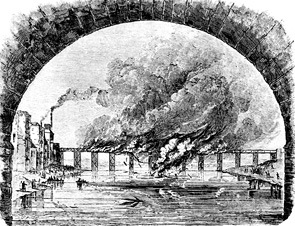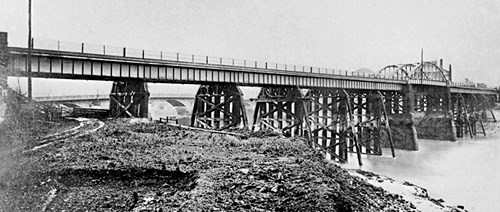Timber Railway Viaducts in Wales
Timber viaducts : South Wales Railway
The South Wales Railway was constructed in a number of stages between 1846 and 1856. Its engineer was
Isambard Kingdom Brunel (1806-1859). In this section, we look at the various timber structures, proposed and completed, that are associated with the line.
Proposed Severn and Wye crossings
In 1844, when Brunel was planning the line, one of the main obstacles facing direct communications to South Wales was the River Severn. He proposed to cross it with a timber viaduct, and also to use a wide span of timber at Chepstow. In November 1844, Brunel answered a request by Charles Blacker Vignoles (1793-1875) for his views on large timber works on the Waterford & Limerick Railway (by Vignoles). He made no comment on the design, but said, "... I have used timber a great deal in construction and see no difficulty in making arches for railways of 250 feet span — in fact I am projecting a larger one at the present".
When Brunel's Severn crossing plans became known, a petition by the Mayor and the interested parties of Gloucester was raised against possible constraints on navigation. However, the main objection was raised by the Admiralty. In June 1845, James Walker (1781-1862), acting for the Admiralty, reported against the proposal. He stated that he had been instructed on 28th March 1845 to inform the Lords of the Admiralty of his opinion of the effects upon the navigation of the River Severn by two bridges.
The first and most important of the two railway bridges was, "... proposed to cross ... at Frethern, half a mile above Hock Crib, three miles below Newnham, or twenty miles below Gloucester". The second was to cross at Priding, 4.8km above Newnham, heading for the Forest of Dean, Monmouth and Hereford.
The importance of Severn navigation is illustrated by the annual tonnage passing the sites of the proposed bridges. In 1845, this was 368,800 tonnes, or about 1,000 tonnes a day. The vast majority of traffic was barges or trows fitted with lowering masts. The figure excludes the 208,300 tonnes that passed through the Gloucester & Berkeley Canal, leaving it at Sharpness Point.
In the report, Walker describes the bridges as, "... of timber, the soffits level, the distance between the piers fifty-seven feet, and the piers themselves three feet, the clear navigation height above high water twenty-two feet, and above low water forty-two feet. Mr. Brunel states, that if fifty-seven feet be thought too little, the Railway Company would agree to extend the openings to even one hundred feet clear opening".
In anticipation of objections to interference with the clear navigation, the railway company also proposed a straight cut or canal across the horse-shoe bend of the river, from Hock Crib to Framilode, a 2.4km cut that would save some 13km travle distance.
Walker comments further: "Even supposing the openings to be 100 feet, as some of the trows are seventy-six feet long, there must be a risk of their being lifted up 'broadside on' and striking the piers".
In light of the navigational difficulties, and unless a safe substitute for the present channel was found, Walker considered the objections to be decisive "... in preventing the execution of the Railway bridges". There was still the canal option. However, Walker concludes that although Brunel is prepared to do whatever may be reasonably demanded, "... none of the plans I have seen give a reasonable probability of accomplishing [the demands of the trade]".
For the time being, Brunel abandoned his ideas for timber crossings on the Severn and went "the long way round" through Gloucester. He later considered a wrought iron single span alternative for the Severn crossing when contemplating designs for the River Tamar bridge at Saltash in Cornwall. His sketch is headed "Severn Bridge. Q: is 1,100ft practicable?"
Interestingly, Brunel developed his idea for a "tubular suspension bridge" when he decided not to use timber to span the river Wye at Chepstow. He rejected his first thoughts for a trussed timber structure to make a total crossing of 183m. In his design, a wrought iron tubular arch takes the pull of the suspension chains from which a girder bridge deck is suspended.
Usk Viaduct, Newport
Crossing the River Usk at Newport was effected by a timber viaduct 366m long, consisting of 11 spans ranging from 12.2m to 15.8m, with a main span of 30.5m for river navigation. The cost of constructing the Usk Viaduct exceeded £20,000 and, according to local legend, it was pronounced by engineers to be the finest structure ever put together.
Disaster struck on 31st May 1848, when the viaduct was almost complete. Fire destroyed almost two years of work. Some 2,264 cu m of timber had been used, every beam of which had been immersed in a tank of flammable creosote for over 12 hours at a pressure of 827.4kN per sq m.
Taff Bridge, Cardiff
At Cardiff, a wooden bridge crossed the old bed of the River Taff, and the new cut to the west (the course of the present river) was to be crossed by a seven-arch stone bridge. However, examination of a photograph taken around 1865 shows a timber bridge over the new cut.
Landore Viaduct
With no major crossing of the River Severn, and Brunel developing the wrought iron
Chepstow Bridge to cross the River Wye,
Landore Viaduct become the longest and most substantial of his timber works in Wales, and indeed anywhere. The assistant engineer in charge of its construction (in effect resident engineer) was
Lavington Evans Fletcher (1822-97).
The viaduct crossed the River Tawe, Swansea Canal and the Landore Marshes near Swansea, forming a continuous structure 536m long, with 37 spans ranging from 12.2m to 30.5m. It was reputedly made from Canadian pitch pine, and cost £28,720 to build. The viaduct opened with the running of the first train between Chepstow and Swansea, on 18th June 1850. It was dismantled and replaced with a shorter bridge and embankments less than 40 years later.
Loughor Viaduct
Next came the crossing of the River Loughor, between Llanelli and Swansea, by a timber structure that was to be the last of Brunels timber viaducts to remain in use. Lavington Evans Fletcher again acted as resident engineer.
Loughor Viaduct was 229m long, with a swing bridge at the Swansea end that provided an opening of 12.2m, and 17 further spans of similar size. The swing bridge was used until 1887 and was fixed shut in 1908-9. Wrought iron girders replaced Brunel's timber trusses in around 1880, with new piles added during the work completed in 1909. In 2013, the viaduct was demolished.
Kidwelly Viaduct
At Kidwelly in Carmarthenshire, the railway crossing was intended to be a fixed span. On 23rd January 1846, the Mayor of Kidwelly, John Williams, made a statement that the South Wales Railway proposed to "... erect a fix[ed] bridge across Gwendraeth Fach River...".
However, a fixed viaduct would have impeded navigation and the Town Clerk was instructed to write to the South Wales Railway's solicitors and express caution. If they restricted shipping movement, the Borough of Kidwelly would have had no option but to write to the Lords of the Admiralty and HM Commissioners of Woods and Forests. The railway company backed down, and Kidwelly got its opening bridge. It was a timber trestle with 13 spans, the centre span of which lifted up to allow a 6.1m wide clearance for vessels.

The destruction by fire of Brunel's original timber Usk Viaduct over the River Usk at Newport, Wales, on 31st May 1848. The main span of 30.5m and much of the structure, almost two years of work (the viaduct was not yet complete), going up in smoke.
Image: Stephen K Jones collection
A later view of the Usk Viaduct (demolished). The central span is now bow string girders on masonry piers. Wrought iron spans replaced all the timber spans in the mid 1880s but the timber trestles are Brunel's.
Photo: Stephen K Jones collection
The original
Landore Viaduct (1850), the most substantial of Brunel's timber works in Wales. It runs through a landscape made lifeless by copper smelting. View by an unknown artist in the early 1850s. Within 40 years the viaduct had been replaced.
Image: courtesy Science Museum, London, and S.K. Jones
Looking north at the
Landore Viaduct crossing Swansea Canal. Note the five masonry piers
Image: courtesy National Museum & Galleries of Wales, WI&MM collection
A pre-1907 photo of
Loughor Viaduct (1852), Loughor estuary between Swansea and Llanelli, Wales. It shows its original condition. The viaduct carried two mixed-gauge tracks of the
South Wales Railway, catering for standard and broad gauge trains. After many alterations, it was replaced in 2013.
Photo: Christopher Wallis collection, courtesy Barbara Wallis and Stephen K. Jones






